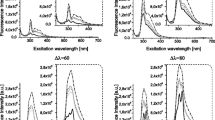Abstract
Fluorescence spectroscopy in combination with multivariate statistical methods was employed as a tool for monitoring the manufacturing process of pertactin (PRN), one of the virulence factors of Bordetella pertussis utilized in whopping cough vaccines. Fluorophores such as amino acids and co-enzymes were detected throughout the process. The fluorescence data collected at different stages of the fermentation and purification process were treated employing principal component analysis (PCA). Through PCA, it was feasible to identify sources of variability in PRN production. Then, partial least square (PLS) was employed to correlate the fluorescence spectra obtained from pure PRN samples and the final protein content measured by a Kjeldahl test from these samples. In view that a statistically significant correlation was found between fluorescence and PRN levels, this approach could be further used as a method to predict the final protein content.











Similar content being viewed by others
References
Warfel JM, Edwards KM (2015) Pertussis vaccines and the challenge of inducing durable immunity. Curr Opin Immunol 35:48–54
Lourenço N, Lopes D, Almeida J, Sarraguça A, Pinheiro C (2012) Bioreactor monitoring with spectroscopy and chemometrics: a review. Anal Bioanal Chem 404(4):1211–1237
Oh Se-Kyu, Yoo Sung Jin, Jeong Dong Hwi, Lee Jong Min (2013) Real-time estimation of glucose concentration in algae cultivation system using Raman spectroscopy. Bioresour Technol 142:131–137
Carrondo M, Alves P, Carinhas N, Glassey J, Hesse F, Merten O, Micheletti M, Noll T, Oliveira R, Reichl U, Staby A, Teixeira A, Weichert H, Mandenius C (2012) How can measurement, monitoring, modeling and control advance cell culture in industrial biotechnology? Biotechnol J 7(12):1522–1529
Lindemann C, Marose S, Nielsen H, Scheper T (1998) Two-dimensional fluorescence spectroscopy for on-line bioprocess monitoring. Sens Actuators B Chem 51(1):273–277
Marose S, Lindemann C, Ulber R, Scheper T (1999) Optical sensor systems for bioprocess monitoring. Trends Biotechnol 17(1):30–34
Skibsted E, Lindemann C, Roca C, Olsson L (2001) On-line bioprocess monitoring with a multiwavelength fluorescence sensor using multivariate calibration. J Biotechnol 88(1):47–57
Hagedorn A, Legge RL, Budman H (2003) Evaluation of spectrofluorometry as a tool for estimation in fed-batch fermentations. Biotechnol Bioeng 83(1):104–111
Royer CA (2006) Probing protein folding and conformational transitions with fluorescence. Chem Rev 106(5):1769–1784
Lakowicz JR (2007) Principles of fluorescence spectroscopy. Springer, NY
Wehry EL (1997) Molecular fluorescence and phosphorescence spectrometry. Handbook of instrumental techniques for analytical chemistry, pp 507–539
Christensen J, Norgaard L, Bro R, Engelsen SB (2006) Multivariate autofluorescence of intact food systems. Chem Rev 106:1979–1993
Harms P, Kostov Y, Rao G (2002) Bioprocess monitoring. Curr Opin Biotechnol 13(2):124–127
Wise BM, Gallagher N, Bro R, Shaver J, Windig W, Koch RS (2007) PLS-Toolbox Version 3.5 for use with MATLAB™, Manual. Eigenvector Research, Inc., Manson
Ohadi K, Legge RL, Budman HM (2015) Intrinsic fluorescence-based at situ soft sensor for monitoring monoclonal antibody aggregation. Biotechnol Prog 31(5):1423–1432
Ohadi K, Legge RL, Budman HM (2015) Development of a soft-sensor based on multi-wavelength fluorescence spectroscopy and a dynamic metabolic model for monitoring mammalian cell cultures. Biotechnol Bioeng 112(1):197–208
Wise BM, Gallagher NB (1996) The process chemometrics approach to process monitoring and fault detection. J Process Control 6(6):329–348
Burstein EA, Vedenkina NS, Ivkova MN (1973) Fluorescence and the location of tryptophan residues in protein molecules. Photochem Photobiol 18(4):263–279
Rover L Jr, Fernandes JC, Neto GdO, Kubota LT, Katekawa E, Serrano SH (1998) Study of NADH stability using ultraviolet–visible spectrophotometric analysis and factorial design. Anal Biochem 260(1):50–55
Gazzotti P, Bock H, Fleischer S (1974) Role of lecithin in d-β-hydroxybutyrate dehydrogenase function. Biochem Biophys Res Commun 58(1):309–315
Militello V, Vetri V, Leone M (2003) Conformational changes involved in thermal aggregation processes of bovine serum albumin. Biophys Chem 105(1):133–141
Deshpande SS (2001) Principles and applications of luminescence spectroscopy. Crit Rev Food Sci Nutr 41(3):155–224
Junker M, Schuster CC, McDonnell AV, Sorg KA, Finn MC, Berger B, Clark PL (2006) Pertactin beta-helix folding mechanism suggests common themes for the secretion and folding of autotransporter proteins. Proc Natl Acad Sci USA 103(13):4918–4923
Crowley-Luke A, Reddin K, Gorringe A, Hudson MJ, Robinson A (2001) Formulation and characterization of Bordetella pertussis fimbriae as novel carrier proteins for Hib conjugate vaccines. Vaccine 19(25–26):3399–3407
Seabrook RN, Atkinson T, Irons LI (1991) A spectroscopic and conformational study of pertussis toxin. Eur J Biochem 198(3):741–747
Persson T, Wedborg M (2001) Multivariate evaluation of the fluorescence of aquatic organic matter. Anal Chim Acta 434(2):179–192
Singh RM (2007) Oxidative stress evokes a metabolic adaptation that favors increased NADPH synthesis and decreased NADH production in Pseudomonas fluorescens. J Bacteriol 189(18):6665–6675
Sigler KC (1999) Oxidative stress in microorganisms—I. Folia Microbiol 44(6):587–624
Beriault RH (2007) The overexpression of NADPH-producing enzymes counters the oxidative stress evoked by gallium, an iron mimetic. Biometals 20(2):165–176
Cabiscol ET (2000) Oxidative stress in bacteria and protein damage by reactive oxygen species. Int Microbiol 3(1):3
Acknowledgments
The authors would like to thank NSERC (National Science and Engineering Research Council of Canada) and Sanofi Pasteur for the financial support.
Author information
Authors and Affiliations
Corresponding author
Rights and permissions
About this article
Cite this article
Zavatti, V., Budman, H., Legge, R. et al. Monitoring of an antigen manufacturing process. Bioprocess Biosyst Eng 39, 855–869 (2016). https://doi.org/10.1007/s00449-016-1565-1
Received:
Accepted:
Published:
Issue Date:
DOI: https://doi.org/10.1007/s00449-016-1565-1




